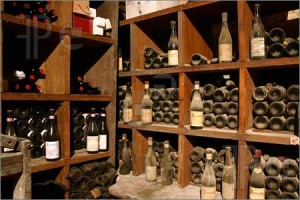- Attached to the essay "Reluctant Baccante"
The wine cellar as confrontation with mortality.
Posted June 28, 2012 8:55 pm One of the essential appeals of “laying down” wine is that you can buy it when it is young and relatively inexpensive, after which it can sit in your cellar aging and taking on value. Over the years, you can chortle at the high price a wine is fetching— in a wine store or on a restaurant menu—that you bought at a bargain price.
One of the essential appeals of “laying down” wine is that you can buy it when it is young and relatively inexpensive, after which it can sit in your cellar aging and taking on value. Over the years, you can chortle at the high price a wine is fetching— in a wine store or on a restaurant menu—that you bought at a bargain price.
You may, however, find it increasingly difficult to drink wine that over time has become what would be by then unaffordable. But you have to. Eventually every wine will reach its peak and then begin to fall off in quality. You must drink it before it rounds the bend.
And herein lies the challenge: it is hard not to identify with the wine in your cellar. You—like it—gets better and better with age, you prefer to think. The bottles may be covered with the dust of time, but inside their precious contents is growing in depth and complexity, gaining a mellow fullness no young wine can approach. What happens when the wine begins to decline, when it loses its strength and softens, when it’s beautiful ruby color turns to brown? Can you disown the metaphor then? Too late!
If you start to buy good wine to put way in your thirties and continue in your forties and fifties, you will end up with a lot of wine that is fast reaching its peak by the time you reach your sixties. Any of the early-purchased wine you haven’t consumed will be over the hill and fast losing all its value, but the next decade of purchases is reaching its peak at the same time. Do you drink the wine that is at its best, writing off the older stuff (or donating it to your children’s school auction), or are you always scrambling to catch up, drinking the soft stuff as fast as you can, so that you can get to the really good bottles which are going soft as the days pass? What a dilemma. Wine is considered by connoisseurs to be a living thing; hence, it is mortal. It is there in your cellar to remind you, should you ever choose to forget.
topics: culture
share
 site feed
site feed


